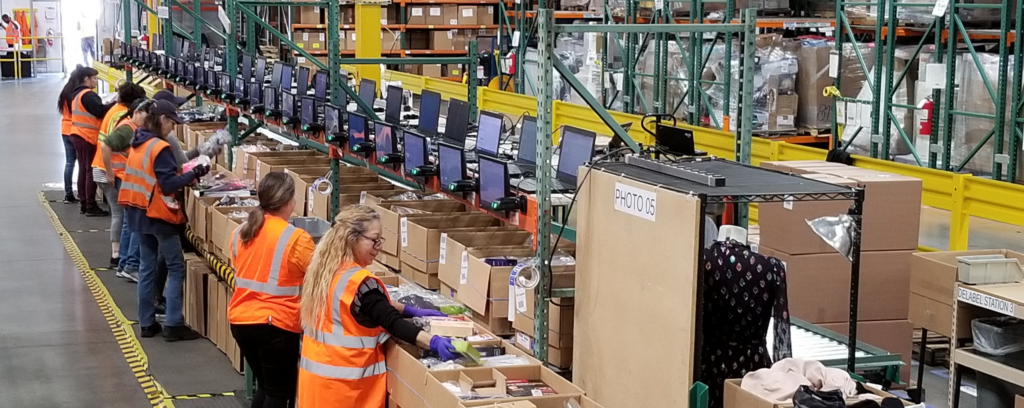Mastering Reverse Logistics:
The Critical Role of Dispositioning Strategy for Retailers

Today in the retail industry there is growing emphasis on reverse logistics, particularly on efficient returns management – of which a key part is dispositioning strategy. Your dispositioning strategy plays a pivotal role in determining how you manage, process, and recover value from returned items.
All too often, however, in the real world we see out-of-date dispositioning processes that were developed years ago and may no longer make sense. In this blog post, we will explore the importance of having a good dispositioning strategy, why regular reviews are key, basic building blocks, and the benefits for retailers.
Understanding Dispositioning Strategy
Dispositioning refers to the systematic approach that retailers use to handle customer returns, including making decisions about what to do with them. Should you restock, refurbish, recycle, liquidate, or dispose? How far upstream should the process begin? Developing a disposition strategy involves strategic decision-making that is essential to optimize resources, minimize losses, and maximize recovery value.
Key Factors in Your Dispositioning Strategy
1. Product condition
2. Volume
3. Seasonality
4. Handling costs
5. Environmental considerations
Assessing product condition and proper sorting of returns is basic. Items that are in like-new condition can be restocked and resold, while damaged or obsolete products can be refurbished, recycled, or liquidated. Out-of-season clothing may need to be liquidated quickly to avoid inventory obsolescence.
Retailers also need to assess the cost implications of different dispositioning options. For example, restocking/reselling may appear to cost less than refurbishment or recycling, but the potential resale value may be less than the extra handling that will be required. Every extra touch also adds cost.
In addition, if you are refurbishing/recertifying, you must consider the impact to the brand – if it’s not done properly and well, you could end up with a negative perception about a lack of quality that could impact new product sales.
Benefits of an Effective Dispositioning Strategy
1. Cost savings
2. Enhanced customer satisfaction
3. Reduced inventory holding
4. Increased sustainability
By making better-informed decisions about dispositioning, retailers can minimize costs associated with handling returns. Opting for the most cost-effective dispositioning method helps maximize profitability.
Further, a well-planned dispositioning strategy improves returns processing, and faster returns processing helps with customer satisfaction. Offering hassle-free returns and efficient handling can also improve brand loyalty. Quick and effective dispositioning reduces the time that returned items spend in inventory, cutting holding costs and freeing up valuable space for more profitable merchandise.
Last, adopting environmentally-friendly dispositioning practices not only contributes to corporate social responsibility, but also aligns with consumer preferences.
The Right Building Blocks
To develop an efficient disposition strategy, start by leveraging your data and analytics. They’ll provide insights into return trends, product condition, and optimal dispositioning strategies – for example, whether it’s worth the extra touches to sort products by value before they are palletized.
Collaborating with suppliers, manufacturers, and third-party logistics providers can streamline the dispositioning process and improve efficiency. The ability to customize the process can also be critical. Every retailer is unique, so be sure to choose a partner who can adapt their processes to yours.
Regularly review and redefine your strategies based on performance metrics and feedback. We recommend reviewing your plan annually and at least once every two years to build a culture of continuous improvement and adapt to changing market dynamics.
How Far Upstream?
Beginning your disposition strategy further upstream in the supply chain can offer several benefits.
1. Proactive Management
By identifying products or components that are more likely to be returned based on historical data or market trends, you can implement strategies to mitigate these returns before they happen.
2. Reduced Costs
For example, identifying quality issues or production errors early in the supply chain can reduce the number of defective products that reach customers, thus decreasing returns and their associated costs, including restocking, transportation, and handling.
3. Improved Product Quality
For OEMs and manufacturers, earlier disposition strategies encourage a focus on product quality throughout the supply chain. By emphasizing QC measures during manufacturing, companies can reduce the likelihood of returns due to defects or poor product performance and keep brand reputation intact.
4. Efficient Inventory Management
Early disposition strategies improve inventory management by identifying slow-moving or obsolete inventory before it becomes a problem. Retailers can proactively discount, repackage, or redistribute these products before they pile up as returns.
5. Better Customer Experience
By ensuring that customers receive high-quality products that meet their expectations, companies not only reduce the frequency of returns, they enhance loyalty and brand reputation.
6. Increased Sustainability
By reducing the number of returns and optimizing inventory management, companies can minimize waste, energy consumption, and carbon emissions.
Final Takeaways
Embracing an effective dispositioning strategy is key to maximizing returns and maintaining a competitive edge in the retail industry. By strategically managing returned products, retailers can minimize losses, keep customers happier, employ sustainable practices, and maximize recovery value.
Need a hand developing your disposition strategy? Interested in outsourcing part or all your reverse logistics operation? Contact us at 800.310.4604 ext. 5500 or email [email protected].



Comments are closed.